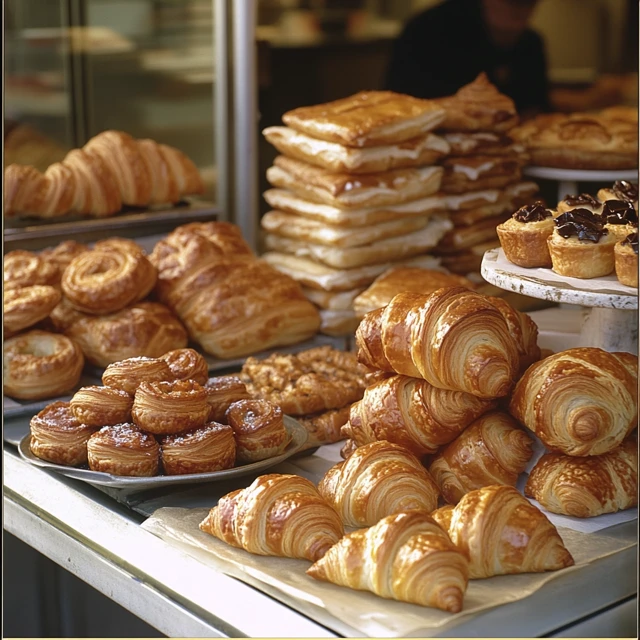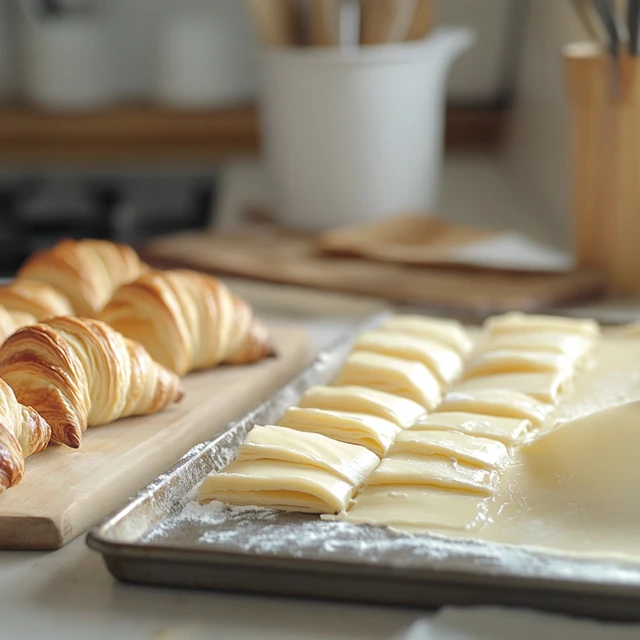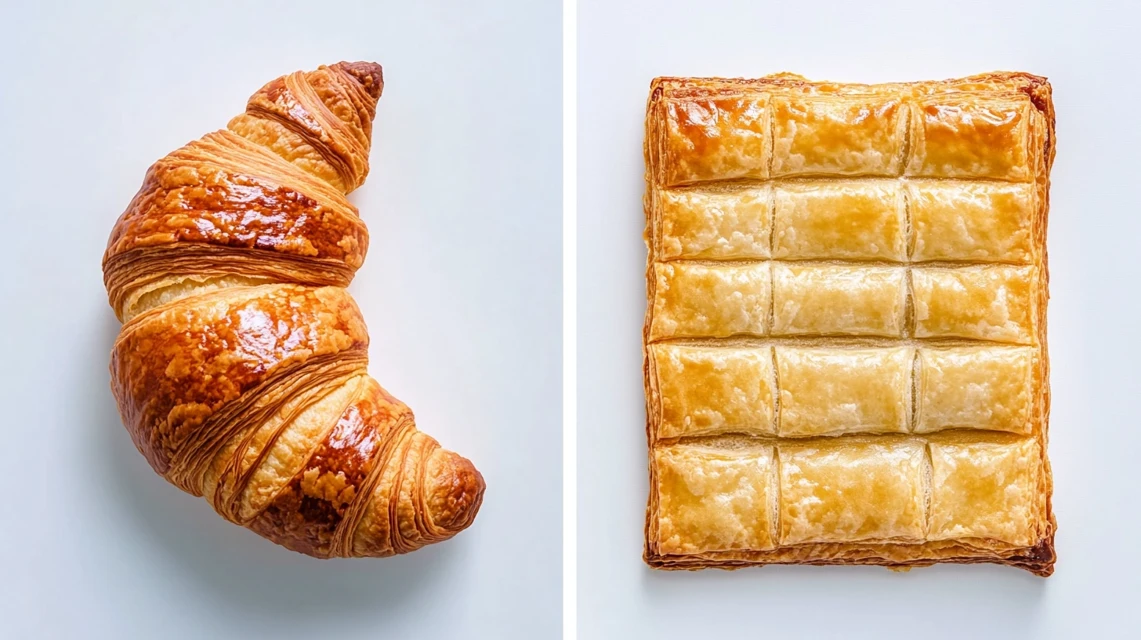What’s the Difference Between Puff Pastry and Croissants? Many people think these pastries are the same since they both have flaky layers and a buttery taste. However, they’re actually quite different in how they’re made and used. Let me help you understand these differences so you can pick the right one for your baking needs.
Understanding Puff Pastry and Croissants
First, let’s look at what makes each pastry special and how people usually eat them.
What Is Puff Pastry?
Puff pastry is a light and flaky dough made by layering butter between sheets of dough. This process creates many thin layers that puff up when baked. As the dough heats in the oven, the butter melts and releases steam, causing the layers to rise and separate.
Key points about puff pastry:
- It has no yeast, so it does not rise like bread.
- It contains simple ingredients: flour, water, butter, and salt.
- It is crisp, flaky, and light in texture.
- It can be used for sweet or savory dishes, such as pies, tarts, and turnovers.
Puff pastry is known for its versatility. You can buy it pre-made or make it from scratch, although the process requires patience and precision.
check out this https://eassyrecipes.com/category/breakfast/
What Is a Croissant?
A croissant is a buttery, flaky pastry that is similar to puff pastry but includes yeast. The yeast allows the dough to rise and creates a softer, bread-like texture. Croissants are famous for their crescent shape and rich flavor.
Key points about croissants:
- They contain yeast, which gives them a light, airy inside.
- The dough is enriched with milk, sugar, and eggs, adding flavor.
- People love to eat them plain or filled with tasty ingredients like chocolate, almond paste, or ham and cheese.
- Croissants take longer to make because the dough needs time to rise.
Many people enjoy croissants for breakfast or as a snack, often pairing them with their morning coffee or afternoon tea for a tasty break.
Why People Confuse Them

Puff pastry and croissants look similar because they both have layers and a buttery taste. Some common reasons people confuse them include:
- Flaky Appearance: Both pastries have thin layers that separate beautifully when baked.
- Common Ingredients: They both contain butter and flour as key ingredients.
- Golden Color: When baked, both pastries turn golden brown and crispy on the outside.
However, the biggest difference lies in how they are made and how they feel when eaten. Puff pastry is crisp and delicate, while croissants are soft and chewy inside.
check out this https://eassyrecipes.com/category/breakfast/
Key Differences Between Puff Pastry and Croissants
Now that we know what puff pastry and croissants are, let’s explore their key differences in terms of ingredients, preparation, and texture.
Ingredients Used in Each
While both pastries use similar ingredients, croissant dough includes a few extra elements that make it unique.
Puff Pastry Ingredients:
- Flour
- Water
- Butter
- Salt
Croissant Ingredients:
- Flour
- Milk
- Butter
- Sugar
- Yeast
- Salt
- Eggs (optional for richness)
The addition of yeast and milk in croissants gives them a softer, bread-like texture. Puff pastry, on the other hand, remains light and crisp because it does not contain yeast or dairy.
Preparation and Baking Methods
These pastries need different steps to make them, even though bakers layer butter in the dough for both treats.
Puff Pastry Process:
- Make a basic dough with flour, water, and salt.
- Roll it out and place a block of butter in the center.
- Fold and roll the dough several times to create thin layers.
- Chill the dough between folds to maintain structure.
- Bake at a high temperature to achieve maximum puffiness.
Croissant Process:
- Make a yeast-based dough with milk and sugar.
- Allow the dough to rise before rolling it out.
- Add butter layers through folding and rolling.
- Shape into crescent rolls and proof before baking.
- Bake until golden and flaky, allowing for a soft, airy interior.
The main difference shows up during baking time: croissant dough must first rise because it has yeast, but bakers can put puff pastry right in the oven after they layer and chill it.
Texture and Taste Differences
One of the easiest ways to tell puff pastry and croissants apart is by their texture and taste.
Puff Pastry:
- Has a crisp and delicate texture.
- Feels light and shatters easily when bitten.
- Tastes buttery but with a neutral flavor, making it suitable for both sweet and savory dishes.
Croissant:
- Has a soft, chewy, and airy inside with crisp layers on the outside.
- Offers a richer, slightly sweet taste due to added sugar and milk.
- Works well as a breakfast or snack pastry, often paired with coffee.
Because of how they’re made, people choose puff pastry when they want something extra crispy. Meanwhile, croissants stand on their own as soft, chewy treats.
check out this https://eassyrecipes.com/category/breakfast/
Common Uses for Puff Pastry and Croissants

What’s the Difference Between Puff Pastry and Croissants? Many people think these pastries are the same since they both have flaky layers and a buttery taste. However, they’re actually quite different in how they’re made and used. Let me help you understand these differences so you can pick the right one for your baking needs.
First, let’s talk about puff pastry and croissants, since each one brings something special to your plate. While puff pastry gives you that crispy, flaky crunch, croissants offer a soft, buttery bite. So depending on what you’re making, you’ll want to pick the right one for your dish. Let me show you how to make the most of both pastries.
Best Uses for Puff Pastry
Bakers love puff pastry because it turns out light and crispy, so they can use it in both sweet and savory dishes. When it bakes, it puffs up into delicate layers that make any recipe look fancy. Here’s how people often use puff pastry:
1. Savory Dishes:
- Appetizers: Puff pastry is great for bite-sized snacks like cheese twists, mini quiches, and stuffed pinwheels.
- Tarts and Pies: It works well for savory tarts topped with vegetables, cheese, or meats.
- Pot Pies: A layer of puff pastry on top of chicken or beef pot pie adds a golden, crispy finish.
- Wrapped Dishes: Puff pastry is commonly used to wrap foods like sausage rolls or baked brie, sealing in flavor while creating a flaky crust.
2. Sweet Treats:
- Turnovers: Puff pastry makes delicious fruit turnovers filled with apple, berry, or custard fillings.
- Napoleons: Layers of puff pastry with cream and fruit create a delicate and elegant dessert.
- Palmiers: Bakers fold sugar into puff pastry and bake it until it turns golden and crispy to make these classic French cookies.
- Cream Horns: You can shape puff pastry into cones, then fill them with whipped cream or custard for a delicious dessert.
3. Everyday Convenience:
Since puff pastry is available pre-made in grocery stores, it’s a great option for quick and easy recipes. It can be cut, shaped, and filled with ingredients to create impressive dishes with minimal effort.
Popular Ways to Enjoy Croissants
Since croissants have such a soft, buttery texture, they taste great with both sweet and savory flavors. So whether you eat them plain or stuffed with fillings, you can enjoy these treats any time of day. Let me show you some of the most popular ways people love to eat croissants:
1. Breakfast Favorites:
- Plain Croissants: Enjoy them fresh with butter, jam, or honey for a simple breakfast.
- Filled Croissants: Common fillings include chocolate, almond paste, or ham and cheese for a hearty morning meal.
- Croissant Sandwiches: Sliced croissants make an excellent base for breakfast sandwiches with eggs, bacon, or avocado.
- French Toast: You can dip croissants in an egg mixture and cook them up to make a rich, buttery French toast.
2. Snack and Dessert Ideas:
- Chocolate Croissants: A popular choice, filled with rich, melted chocolate inside flaky layers.
- Almond Croissants: Made by filling croissants with almond cream and topping them with sliced almonds.
- Ice Cream Sandwiches: You can easily grab a croissant at bakeries, cafes, and supermarkets, so many people pick up these tasty treats on their way to work or school. For an extra special dessert, you can even split open a croissant and fill it with ice cream.
- Dipped Croissants: Some enjoy dipping croissants in coffee, hot chocolate, or even soup for a comforting experience.
3. On-the-Go Options:
You can easily grab a croissant at bakeries, cafes, and supermarkets, so many people pick up these tasty treats on their way to work or school.
Which One Is Better for Your Needs?
What’s the Difference Between Puff Pastry and Croissants? Many people think these pastries are the same since they both have flaky layers and a buttery taste. However, they’re actually quite different in how they’re made and used. While puff pastry gives you that crispy, flaky crunch, croissants offer a soft, buttery bite. So let’s figure out which one works best for what you want to make.
1. When to Choose Puff Pastry:
- If you want a light, crispy texture that adds a crunch to your dish.
- When you need a versatile ingredient that works well in both sweet and savory recipes.
- If you’re looking for something easy to prepare, since store-bought puff pastry is widely available and convenient.
- Great for baking quick snacks or elegant meals without much effort.
2. When to Choose Croissants:
- If you prefer a soft, buttery texture that’s rich and satisfying.
- When you want a standalone pastry, perfect for breakfast or snacks.
- If you enjoy a richer flavor, thanks to the use of milk, sugar, and yeast in the dough.
- Ideal for those looking for a filling and indulgent treat.
3. Which Is More Versatile?
- Puff pastry is better for creative recipes, from appetizers to desserts.
- Croissants are best for ready-to-eat meals or simple fillings without the need for extra preparation.
FAQs About Puff Pastry and Croissants
Let’s talk about puff pastry and croissants, since people often get confused about what makes them different. So, I’ll answer the most common questions to help you understand each pastry better.
Are Croissants the Same as Puff Pastry?
No, croissants and puff pastry are not the same. While they may look similar, they have key differences.
- Ingredients: Croissant dough includes yeast, milk, and sugar, while puff pastry only uses flour, butter, water, and salt.
- Texture: Croissants are soft and airy inside, with a flaky outer layer. Puff pastry is crisp and light throughout.
- Preparation: Croissant dough requires proofing (resting to rise), but puff pastry does not need rising time.
- Usage: Croissants are typically enjoyed as a breakfast pastry, while puff pastry is used in both sweet and savory dishes.
Croissants contain yeast, which gives them a chewy texture, while puff pastry relies on layers of butter to create a crisp bite.
What Is Puff Pastry Called in English?
In English, puff pastry is simply called “puff pastry.”
What’s the Difference Between Puff Pastry and Croissants? Puff pastry gets its name from how it bakes. First, bakers layer butter between sheets of dough. Then, when it goes in the oven, the dough puffs up and creates light, flaky layers.
In some cases, it may also be referred to as:
- Flaky pastry
- Laminated dough
- Pastry sheets (in pre-packaged forms)
Regardless of the name, puff pastry remains a versatile dough used for everything from appetizers to desserts.
What Type of Pastry Is a Croissant?
What’s the Difference Between Puff Pastry and Croissants? A croissant starts with layers of butter and dough stacked together. When bakers stack them this special way, it creates those flaky layers and rich, buttery taste that people love.
Croissants fall under the category of viennoiserie, a term used for pastries that include yeast and other enriching ingredients like milk and sugar. Viennoiseries are a cross between traditional bread and pastry, offering a slightly sweet, airy texture.
Key features of croissant dough:
- Made with yeast for a light, airy structure.
- Contains milk and sugar for added flavor.
- Rolled and folded multiple times to create flaky layers.
- Baked to achieve a golden, buttery crust with a tender inside.
Croissants are often enjoyed plain, filled with chocolate, or topped with almonds and powdered sugar.
What Is a Substitute for Puff Pastry?
If you don’t have puff pastry on hand, several alternatives can be used, depending on the recipe.
1. Phyllo Dough:
- Thin, delicate layers of dough.
- Lighter and crispier than puff pastry.
- Works well for dishes like spanakopita or baklava.
2. Crescent Roll Dough:
- Softer and bread-like texture.
- Pre-packaged and easy to use.
- Suitable for sweet and savory fillings but lacks crispness.
3. Pie Crust Dough:
- Denser and more crumbly.
- Ideal for pies and tarts but doesn’t puff up.
- Works best in savory dishes that require a firm crust.
4. Biscuit Dough:
- Soft and fluffy texture.
- Not as flaky but provides a buttery taste.
- Great for dishes like pot pies.
Each substitute offers a unique texture and flavor, so choosing the right one depends on the dish you are making.
Conclusion
What’s the Difference Between Puff Pastry and Croissants? While they might look similar, each one has its own special qualities. Puff pastry turns out light and crispy, so it works great in many recipes. Meanwhile, croissants stay soft and buttery, making them perfect for breakfast. Knowing these differences helps you pick the right pastry for your recipe, whether you buy them from the store or make them at home.

